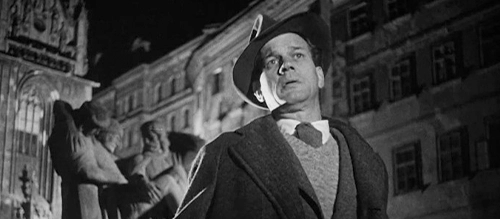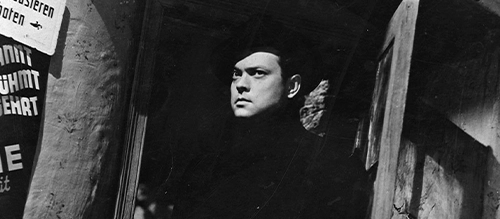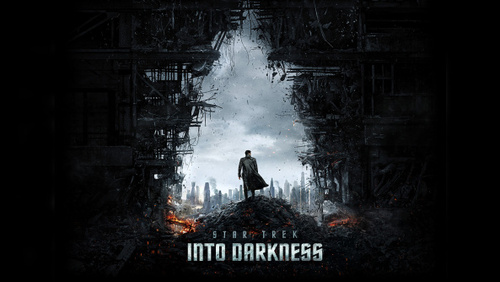
The Third Man (1949)
Director: Carol Reed
Screenwriters: Graham Greene
Starring: Joseph Cotton, Alida Valli, Orson Welles, Trevor Howard, Bernard Lee
The Third Man is a film that is more legend than picture. A Palme d’Or winner in 1949, and winner of the Academy Award for Best Cinematography – Black and White for Robert Krasker in 1951, Carol Reed’s film was critically successful in its time and has gone on to top dozens of best-of lists over the decades that have followed. It is now considered by many experts to be one of the best films ever made, with some of the best performances, music, and cinematography ever crafted.
Based upon a novella written by Graham Greene (written to bash out the screenplay before putting it into script form), The Third Man finds itself placed in the midst of post-war Vienna, a city split up into quadrants by various controlling nations. Into this strange, ruinous city comes Holly Martins, played by Joseph Cotton (known, aside from his Orson Welles collaborations, for The Philadelphia Story, Shadow of a Doubt, and Gaslight), a writer of pulp Western novels. He’s here because his old friend, Harry Lime (Orson Welles), has offered him a job, only to find that Lime has been killed in a car accident shortly before his arrival. Upon asking about him, people seem to have different interpretations about how Harry died, including whether he was killed instantly and how many people were there at the site of the accident. Were there two people taking away his corpse, or was there a third man? Was he, perhaps, murdered?
The noir thriller, a staple of the 1940s war years due to both the paranoia and fear of the period, and the practical consideration of the expense on lighting necessitating dark shadows, was only called such in the years after the heyday of the genre. Here is one of its greatest exponents.
In The Third Man, the true main character is Vienna itself, which is wonderfully captured through the aforementioned Oscar-winning cinematography by Krasker, and through Carol Reed’s direction. Taking inspiration from both film noir and the German Expressionist movements, the city is constantly shown at canted angles, crowded in with sliding chutes of rubble and knickknacks, through bars and balustrades. Everything ominously looms over the thriller storyline as the narrative winds its way through the crowded streets, into the dark, dank sewers; into the underbelly of the black market. The film is less about the characters as it is about a city which is being torn apart as various countries fight for it, eyes and ears everywhere, tension and paranoia rampant. Vienna is the world, the ordinary people detaching their morals and empathies to scrap and survive in an environment that does not care for them.

This in turn aids some of the best performances ever put to screen. Specifically that of Orson Welles as Harry Lime. Welles is at a career high here, his portrayal bordering on and perhaps even beating his turn in Citizen Kane (1941). Krasker’s cinematography gives us some of the most iconic moments of Welles on screen – both his initial appearance and his eventual chase through the sewers are unforgettable. Welles’ charm and charisma makes Lime the ultimate noir character, both impossibly bad yet likeable, forever burned into our minds. Joseph Cotten, putting in a tremendous turn of his own as Martins, is the leading light, and he’s an incredible performer – The Third Man is one of his career-best turns – but he is completely outshined whenever Welles enters the room.
The strange tunnel that the film lures you into – the world of the good and the bad and the confusion of the two – is all the while accompanied by Anton Karas’s famous Zither score, dispensing with the traditional orchestral score that was commonplace for film noir thrillers at the time. The waltz-like strings give a kind of carnivalesque atmosphere to the film, which marries the dark backdrop of the story to sounds you could consider almost cheery. A sinister dimension is added as a result. Commonly known as the Harry Lime Theme, it perhaps reflects the world view of a man who doesn’t care much about who he harms as long as he can flounce and dance his way through the wreckage of the world. The score is at odds with convention, and that’s what makes it work so well.
The dialogue is iconic. The cinematography is breathtaking. The performances stand the test of time. The direction borders on perfect; no wonder Reed also got an Oscar nomination. The story weaves and meanders a little, with a few ends that aren’t tied up as nicely as you’d like, but you don’t care because it is still perfectly suited to the tone and feel and place and time. Nothing is meant to be neat and tidy, and it is only through the neatness and tidiness of the rest of the film’s presentation that you can appreciate that. The Third Man is revered as one of the greatest films ever made, and justifiably so.
Score: 23/24
Recommended for you: Where to Start with Orson Welles

